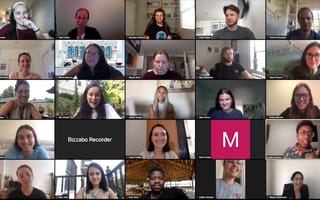
After many companies overcame the hurdle of transitioning to remote work — with supportive resources like home office stipends — they encountered an even more pressing and evolving challenge: maintaining employee wellness.
Employee needs can differ greatly, and as work-from-home (WFH) life continues, those needs can change. The uncertainty of the times can lead to stress, burnout and a lack of engagement and productivity. Parents have to adjust to new school schedules and childcare responsibilities.
Businesses have a continuous responsibility to protect the mental health of their employees and support them in ways that matter most today. GrubHub, Pager, Bizzabo and Newsela all said they approach their support strategies by listening to staff. Regularly fielding employee surveys and feedback helped these companies adapt to a changing remote world with new and improved wellness-driven resources and perks.
We learned about a wide variety of creative resources these four New York companies built based on employee feedback, like creating a remote learning toolkit for parents adjusting to school closures, providing more vacation days, dedicating time to meditation and more.
How K-12 education content provider Newsela adapted its perks to remote work: There were four key goals that we focused on: supporting employees that have caregiver responsibilities, helping teams build productive remote work environments, promoting self-care and simplifying access to benefits and resources.
Because we’re an edtech company, we are fortunate to have in-house experts on digital learning and curriculum that enabled us to coordinate internal resources for navigating the impact of school closures. We offered a caregiver toolkit, reading clubs for distance learning and reviews of different external learning resources from our chief academic officer. We also provided a child learning stipend for caregivers to put toward learning resources and activities for their kids. For all Newselites, we introduced a remote office stipend, on top of our existing monthly tech stipend, which could be used for anything that would improve remote comfort and productivity.
We enabled asynchronous work through meeting recordings.”
Supporting employee mental health: Building off of our monthly wellness program, we launched weekly Zen breaks to carve out time for employees to recharge, decompress and recenter. We have guided meditation, chair yoga and 30-minute workouts. We upped our paid sick leave to cover a full month’s absence and expanded our access to all-hours virtual care through a concierge health provider, One Medical.
Beyond that, we focused on creating boundaries, encouraging employees to take time off and normalizing flexible work schedules. We enabled asynchronous work through meeting recordings and workflow management boards to accommodate caregiver schedule flexibility needs. We also extended companywide holidays to ensure everyone is taking vacation time without the pressure of having to catch up or check in during their time off.
How employee feedback influenced new perks: We use several feedback channels to inform how we approach everything at our company: a semi-annual employee survey, an anonymous feedback form, skip-level meetings and manager check-ins. We surveyed our team members at the beginning of COVID-19 to guide our efforts. That survey led to our remote office stipend and underscored the need for company-sanctioned time off, which prompted us to extend all-company holidays and encourage greater use of our unlimited flexible PTO policy.
Employee feedback also helped us reshape our bi-weekly manager training sessions, where we included workshops on managing fully remote teams and proactively identifying and addressing stress based on personality type. All these led to an increase in coffee hangouts, game nights, Zoom skill-shares and a remote Bring Your Child To Work day.
How healthtech communication platform Pager adapted its perks to remote work: Since our transition to remote work life, we’ve tried to both maintain our existing traditions and find new ways to help our team members connect with each other. Our usual all-hands meetings, game nights, movie and book clubs are now alternating weekly virtual meetings. We also introduced a weekly breakfast club and lunch table, which encourage team members to catch up and make new friends. In lieu of our biannual engineering onsites, we created a number of virtual events that still allow our entire team time to enjoy each other’s company, solve problems and have fun together during the work day.
All of our new perks and benefits are shaped by the team members that will use them.”
Supporting employee mental health: Our people ops team hosts three weekly “Headspace Huddles” that offer time during the work day for self-reflection, meditation and breathing room. We also instituted Pager Days, which are an extra day each month that team members have off work to spend how they choose.
We continually work to understand how current events and social pressures affect our team members. So we’ll be hosting workshops on wellness and diversity, inclusion and equity alongside our virtual field day events. We’re also building out new ERGs for our team in addition to our existing ones; we have a PLUS group for LGBTQIA+ team members to discuss current events, queer media and participate in events, and Wakanda for Black employees to share mental health resources and celebrate Black excellence.
How employee feedback influenced new perks: The easiest way to ensure that employee needs are met is by talking to them and making sure their voices are heard. We often use pulse surveys on certain subjects to get a sense of how our team feels and what their needs are. We created a culture committee with representatives from every department to ensure that our culture is built in an inclusive way by the whole team. Now, all of our new perks and benefits are shaped by the team members that will use them.
How mobile food-ordering and delivery platform GrubHub adapted its perks to remote work: When we transitioned our workforce to remote in March, we provided all employees with information on access to medical care and telehealth, COVID-19 symptoms and how to access our employee assistance program for mental health concerns. Then we issued a stipend to make sure everyone had the resources they needed to create a comfortable work-from-home environment.
In lieu of office snacks and lunches, we increased our meal perks allowance that offers employees a set weekly budget to order from local restaurants on Grubhub. If an employee didn’t spend all their weekly perks, we donated the remainder to our Grubhub Community Relief Fund that provides financial relief for our community. The people team also created a library of resources that included guides on leading a remote team, local virtual events, remote team-building ideas and creative collaboration tools.
Our ability to remain productive and engaged at work is dependent on taking care of the self first.”
Supporting employee mental health: Our Working Parent and Black Employee Affinity Groups increased their opportunities to meet virtually, share resources and support each other through the challenges of the last several months. Wellness Wednesdays are a time for virtual fitness, yoga and meditation classes. They are a highlight for many and are recorded so that anyone can access them at their convenience.
We offer a menu of options that appeal to our diverse community with virtual cooking demos, happy hours, podcasts and lunch and learns. Most importantly, we encourage balance and wellness by setting “meeting-free” times where staff can get off their screens and prioritize self-care.
How employee feedback influenced new perks: There is no one-size-fits-all solution to what people need. The most important thing we can do right now is listen to our people and support them in ways that are most meaningful to them. Our ability to remain productive and engaged at work is dependent on taking care of the self first.
To fully understand what support would be most effective, we surveyed our people every 30 days at the beginning of our time at home. All of our initiatives, stipends and resources were a direct result of employee feedback. By listening to our people and delivering on their feedback, we hopefully have sent a strong message that says, “We see you, we hear you and we care about you.”
How event marketing platform Bizzabo adapted its perks to remote work: Based on employee feedback, we built a variety of remote work benefits including full coverage for remote therapy to encourage mental health, a grant to help parents cover child care costs before school reopens and additional mental health days through the end of the year. We also have remote classes for yoga, fitness and cooking, a WFH stipend to build a remote office space and additional team-building activities like sponsored lunches, happy hours, games and comedy hours.
Capturing feedback helped us design a dynamic and curated perks and benefits program.”
Supporting employee mental health: We learned quickly that remote work has positives and negatives. Our team has been able to work more flexibly. However, working remotely can sometimes make it difficult to unplug.
We encourage a healthy work-life balance by providing additional mental health resources through BetterHelp and mental health days. Our people team also checks in with team members during one-on-ones to provide additional resources, links and support to manage work-life balance.
How employee feedback influenced new perks: Employee feedback is critical for designing and implementing an impactful perks and benefits program. We ran multiple surveys and one-on-one discussions during the last few months to get a pulse on employee happiness and engagement. We sourced feedback on what programs are working well and where we can improve. An interactive, data-driven process for capturing feedback helped us design a dynamic and curated perks and benefits program that maximizes value for all our employees.












